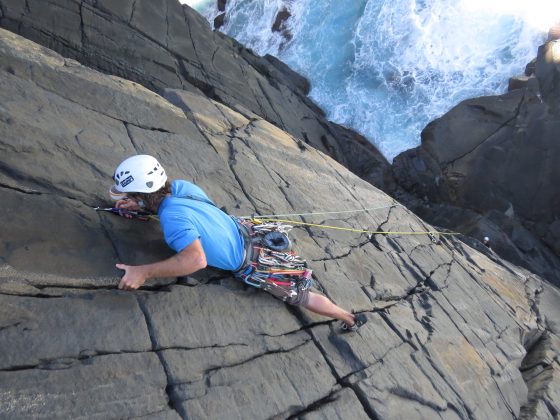
Dear climbers,
The Albany Coast Draft Management Plan 2016 was released by DPaW for public comments on 9th May 2016. Thanks to several CAWA committee members who scrutinized the plan, CAWA submitted comments on 6th July 2016.
BACKGROUND INFORMATION:
The Draft Albany Management Plan covers 56 existing terrestrial parks and reserves totalling 32,457ha (Map 1, Appendix 1 of the plan). The lands are mainly located in the City of Albany, as well as southern parts of the shires of Plantagenet and Jerramungup. Climbing areas covered by the plan include the Gap, Natural Bridge, and Peak Head in the Torndirrup National Park, West Cape Howe in the West Cape Howe National Park and Waychinicup in the Waychinicup National Park. As it covers such a large area and variety of parks, it is written more strategically than other management plans.
This management plan, once gazetted, will replace all of the below listed plans as the statutory management plan for the parks and reserves within the planning area (including any proposed reserves that become vested with the Conservation Commission):
- South Coast Regional Management Plan 1992–2002 (CALM 1992a)
- Two Peoples Bay Nature Reserve Management Plan 1995–2005 (CALM 1995a)
- West Cape Howe National Park Management Plan 1995–2005 (CALM 1995b)
- Interim management guidelines for Torndirrup, Gull Rock and Waychinicup national parks, as well as Mount Manypeaks and Arpenteur nature reserves
- A non-statutory management plan also exists for Cheyne Bay: Cape Riche to Pallinup River (reserves 14986, 14987 and 31240)
Note that the Stirling Range and Porongorups are covered in the Stirling Range and Prongorups Management Plan, and Peak Charles is covered in the Esperance and Recherche Archipelago Management Plan that came into effect last year. (These were previously covered by the South Coast Regional Management Plan).
The strategic objectives of the Draft Albany Management Plan, which are derived from corporate DPaW objectives and provide overall guidance for the planning area, are:
- to conserve and protect biodiversity and ecological integrity;
- to conserve and protect the value of the land to the culture and heritage of Noongar people, and conserve and protect other cultural heritage;
- to provide for recreation, tourism and community use for the appreciation of the area’s landscape, natural and cultural heritage values; and
- to provide for sustainable resource use.
For context, the parks and reserves covered by the Management Plan have immense importance for biodiversity, Noongar and other cultural heritage, as well as have spectacular coastal landforms and scenery that attract many visitors, and are an integral part of the greater Albany community. It will always be a balancing act to maintain the above listed objectives.
As a background, the parks are located within the global biodiversity hot-spot of the South West Botanical Province. The Albany coast area has high conservation value based on the presence of several large and intact protected areas such as the Gull Rock, Torndirrup, Waychinicup and West Cape Howe National Parks and Two Peoples Bay Nature Reserve; areas of high plant species diversity and endemism; and important refuges for threatened fauna (including the critically endangered Gilbert’s potoroo or ngilgyte (Potorous gilbertii) and several endangered ground-dwelling birds, flora and ecological communities.
The plan recognises that recreation (in all its forms) within the planning area mainly occurs along the coastal strip, and the major focus for visitor use is at Torndirrup, West Cape Howe, Gull Rock and Waychinicup national parks and Two Peoples Bay Nature Reserve. While the majority of recreation sites within the planning area are associated with the provision of access to beaches and coastal inlets, and much of the activity at these sites is water based, these coastal parks and reserves also provide:
- spectacular scenic destinations
- a rustic, remote and wild sense of place
- unique and varied landscapes
- opportunities for numerous nature-based recreation activities and multi-user groups
- unique natural experiences.
Consequently, the number of visitors to these popular coastal parks and reserves are high. In 2013–14, Torndirrup National Park was the sixth highest visited park/reserve in the State with about 431,528 visits (70% of the combined parks visits), and the most visited reserve in the planning area. ‘The Gap’ and ‘Natural Bridge’ sites within this park attracted about 209,587 visits alone (half of the visits were to the park). In comparison, Two Peoples Bay Nature Reserve received about 107,000 visits, Waychinicup National Park received about 14,500 visits and West Cape Howe National Park received about 49,134 visits.
CAWA recognises that climbing is only one activity of many that occur within the numerous parks covered with the planning area of the Draft Albany Management Plan, but the plan contains several key and very important climbing areas. This and the consideration of the above mentioned considerations are reflected in CAWA’s submission to DPaW submitted on 6 July 2016.
Download CAWA’s response to the Albany Coast Draft Management Plan – July 2016 (PDF)
Any questions or burning desire to help out with access issues in the future, contact us on access@climberswa.asn.au.
Thanks,
CAWA Access sub-committee
